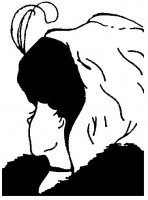Widgetized Section
Go to Admin » Appearance » Widgets » and move Gabfire Widget: Social into that MastheadOverlay zone
What Color Is the Dress?
The views expressed are those of the author and do not necessarily reflect the views of ASPA as an organization.
By Susan Paddock
May 8, 2015
The Great Dress Debate of 2015 began when a woman posted a picture of the polarizing garment to Tumblr and asked for help in identifying its colors. The dispute quickly spread to Twitter, where people split into two camps: #teamblueandblack and #teamwhiteandgold.
The dress actually is black and blue, but many (including me) saw it as white and gold. The culprit was our retinas, specifically the cones that perceive colors in a slightly different way depending on our genes. It is nearly impossible to convince anyone that the dress is a color other than what they perceive and more than one vigorous argument often results.
 What this story illustrates is how easy, and perhaps natural, it is to see “truth” in very different ways depending not just on our prejudices and biases, but also on ways in which our brains perceive things. There are consequences of these differing perceptions. In organizations we become convinced of “truth” and create programs and policies based on that truth. For example, what is the truth of why people are on welfare? Why some neighborhoods have more crime? Why some students, in some classrooms, learn better than other students?
What this story illustrates is how easy, and perhaps natural, it is to see “truth” in very different ways depending not just on our prejudices and biases, but also on ways in which our brains perceive things. There are consequences of these differing perceptions. In organizations we become convinced of “truth” and create programs and policies based on that truth. For example, what is the truth of why people are on welfare? Why some neighborhoods have more crime? Why some students, in some classrooms, learn better than other students?
The “truth” gains strength and credence if a majority of people believe it. Democracy – majority rule – does not necessarily lead to truth or the best outcomes. Instead, it leads to an agreement on what is considered the “right” answer as perceived by the majority.
A better way to search for “truth” might be through consensus. A study done years ago found that people were most satisfied with a decision if that conclusion was reached by consensus rather than by majority rule. Consensus allows a variety of “truths” to emerge and to develop a variety of programs and policies to reflect those truths.
In the 1980s, the Phoenix, Arizona area experienced several years of significant floods which significantly disrupted business and brought traffic to a crawl. Authorities searched for an answer to this problem and the truth seemed evident: build one or more dams. But this truth did not reflect other truths such as the rights and territorial traditions of Native American tribes, the habitat requirements of eagles and other species and the economic interests of cities along the Salt River.
A long participatory process led to a new “truth” that respected the variety of interests and created flood control and water retention entities that not only responded to the original issue but also produced collaborative structures that remain active today. The “truth” was neither blue and black, or white and gold but something else entirely new.
Kentucky, like other states, struggled with rising costs of its correctional system. For most states, the way to decrease the costs of incarceration has been to find alternatives like electronic monitoring or increased supervision of probation. But Kentucky found another truth: controlling costs by decreasing recidivism through an intensive re-entry program. They accomplished this by increasing the services provided to parolees, so that released felons were able to find jobs, receive health and social welfare services and become integrated into the community. Despite spending more on parolee services, the cost of correctional services declined.
The Ferguson riots led to one truth: citizens were angry at the police because of a history of discriminatory enforcement. The more recent Baltimore riots suggested another truth: it was not simply discriminatory policing (after all, Baltimore’s police force has many black officers) but rather a history of high unemployment and entrenched poverty that caused the civil protests to become destructive riots. The truth was still race-based, but in a different, broader way. Police were seen as the symbol of a system that had not responded to the real needs of the respond community. Responding to only one truth (that policing is race-based) risks taking action that does not solve the problem. Being able to understand, and respond to, multiple truths can lead to more significant remedial policies and programs.
On an organizational level, a governmental office was divided on the issue of “morale.” Some employees believed there was a problem, while others (the majority) did not. The disagreement resulted in tense working relationships and rising distrust. What distinguished the two groups was the amount of freedom that any employee had in determining work hours, work processes and expected outcomes. The real truth, then, was something other than morale. It was neither blue and black or gold and white. It was something else instead and may have been discovered in employee engagement or participatory decision making efforts
The willingness to embrace multiple “truths” or to allow truth to be ambiguous permits more employees in a workplace or citizens in a community to feel a part of the decision making process and organizational outcomes. Being willing to consider alternative truths may allow us to change what we think is possible. Practicing the challenging task of considering multiple truths is a healthy exercise – for our organizations, and for our communities.
Author: Susan Paddock is a University of Wisconsin-Madison emeritus professor who currently lives and works in Las Vegas, Nevada. Email [email protected].


Follow Us!